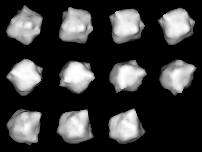3908 Nyx
3908 Nyx is an Amor and Mars-crosser asteroid. It was discovered by Hans-Emil Schuster on August 6, 1980, and is named after Nyx, the Greek goddess of the night, after which Pluto's moon Nix is also named. It is 1–2 km in diameter and is a V-type asteroid, meaning that it may be a fragment of the asteroid 4 Vesta.
 | |
| Discovery | |
|---|---|
| Discovered by | Hans-Emil Schuster |
| Discovery date | 6 August 1980 |
| Designations | |
| (3908) Nyx | |
| Pronunciation | /ˈnɪks/"Nyx". Dictionary.com Unabridged. Random House. |
Named after | Nyx |
| 1980 PA; 1988 XB1 | |
| Amor; Mars-crosser | |
| Adjectives | Nyctian |
| Orbital characteristics[1] | |
| Epoch 27 July 2005 (JD 2453578.5) | |
| Uncertainty parameter 0 | |
| Observation arc | 13021 days (35.65 yr) |
| Aphelion | 2.81198 AU (420.666 Gm) |
| Perihelion | 1.04239 AU (155.939 Gm) |
| 1.92719 AU (288.304 Gm) | |
| Eccentricity | 0.45911 |
| 2.68 yr (977.20 d) | |
| 99.7699° | |
| 0° 22m 6.236s / day | |
| Inclination | 2.17667° |
| 261.688° | |
| 125.978° | |
| Earth MOID | 0.0563399 AU (8.42833 Gm) |
| Physical characteristics | |
Mean radius | 0.5 ± 0.075 km |
| 4.42601 h (0.184417 d) | |
| 0.23 | |
| V | |
| 17.3 | |
Observations
In 2000, radar observations conducted at the Arecibo and Goldstone observatories produced a model of Nyx's shape; the asteroid can best be described as spherical but with many protruding lumps.
Name
To avoid confusion with 3908 Nyx, Pluto's moon Nix was changed from the initial proposal of the classical spelling Nyx, to Nix.[2]
gollark: Has everyone made sure to submit their entry for the list sorting competition or else? I finally got mine in.
gollark: You can trust random programs downloaded off the internet on Linux because they almost certainly won't run unless you compile them yourself.
gollark: osmarks.tk runs on an unfortunate amount of Node.js services and even one *PHP* one.
gollark: As always, I am highly helpful™, thus moderator promotion WHEN?
gollark: It is!
References
- "3908 Nyx (1980 PA)". JPL Small-Body Database. NASA/Jet Propulsion Laboratory. Retrieved 11 April 2016.
- "Planet and Satellite Names and Discoverers". Gazetteer of Planetary Nomenclature. USGS Astrogeology. 21 July 2006. Archived from the original on 19 August 2006. Retrieved 15 August 2006.
External links
- 3908 Nyx at NeoDyS-2, Near Earth Objects—Dynamic Site
- Ephemeris · Obs prediction · Orbital info · MOID · Proper elements · Obs info · Close · Physical info · NEOCC
- 3908 Nyx at the JPL Small-Body Database

This article is issued from Wikipedia. The text is licensed under Creative Commons - Attribution - Sharealike. Additional terms may apply for the media files.